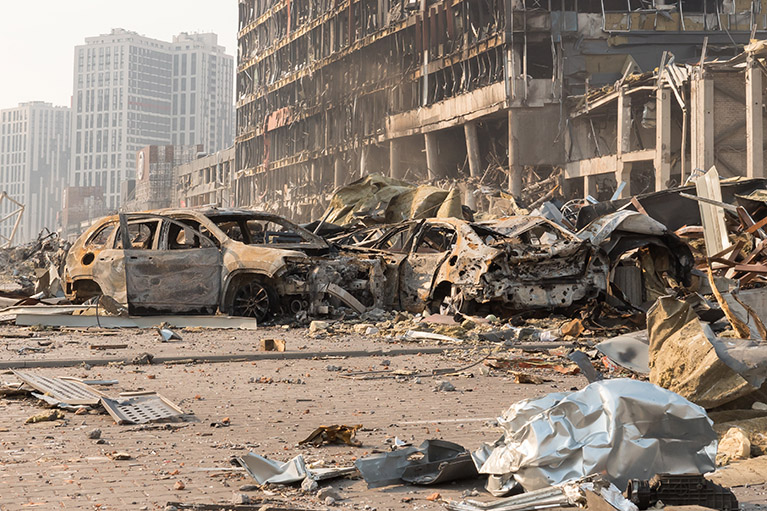One could be forgiven for thinking that the war in Ukraine is all about military hardware. That too, assuredly, is important, but the conflict is also about something more mundane: maintaining a functioning state.
Take a simple issue, what happens if Ukraine runs out of money? What happens if suddenly there isn’t enough to pay nurses, teachers, and police officers?
Things are dire. But, perhaps, not quite as catastrophic as some might think.
No doubt about it, Ukraine is burning through money fast. Very fast. Unsurprisingly, the illegal invasion by Russia, has been costly for the country. According to the International Monetary Fund, Ukraine’s GDP could shrink by 35 percent as a result of the war: https://www.theguardian.com/business/2022/mar/14/ukraine-economy-shrink-2022-imf-russia-war
Add to this that the export of grain and other agricultural produce is severely hampered, even with a deal to ensure passage through the Bosporus Strait.
It is useful to consider how much money Ukraine has received and been promised by allies. Take the USA. According to official figures, “The United States has committed approximately $5.3 billion in security assistance to Ukraine since the beginning of the Biden Administration, including approximately $4.6 billion since the beginning of Russia’s unprovoked invasion”. https://www.defense.gov/News/Releases/Release/Article/3049483/fact-sheet-on-us-security-assistance-to-ukraine/
On December 12th, the New York Times, reported, “The leaders of the world’s wealthiest nations on Monday pledged their unwavering support for Ukraine as they agreed on elements of a new system to funnel short- and long-term funding to a war-torn nation facing a bitterly cold winter and continued Russian aggression. The Group of 7 leaders vowed to support Ukraine in its fight against Russia “for as long as it takes” and aimed to convene a meeting of a new donor coordination platform next month”. https://www.nytimes.com/live/2022/12/12/world/russia-ukraine-news
This is in addition to the help already received by Ukraine. As reported by the Financial Times, “The G7 and EU have announced official financing commitments to Ukraine worth $29.6bn” And in addition, EU leaders have pledged additional support of up to €9bn, on top of a previous €1.2bn emergency loan. https://www.ft.com/content/141a9e85-19ed-47d4-be48-bb9febc76c98
To put it simply, the money promised (and received) from the international partners will at least tie Ukraine over.
Ukraine also still needs to repay its outstanding loans. With little money coming in, it is hard to fulfil its obligations. For that reason, the country has asked for permission to postpone its debt payment earlier this month: https://www.reuters.com/world/europe/ukraine-intends-postpone-debt-payments-24-months-government-resolution-2022-07-20/. This was immediately supported by western governments most notably Germany: https://www.bundesfinanzministerium.de/Content/DE/Standardartikel/Themen/Europa/Krieg-in-der-Ukraine/statement-zum-schuldenmoratorium-fuer-die-ukraine.html
While immediate bills and existing debt are an issue, the more pressing concern for Ukraine is the continuation of the war. The problem facing the country is that of a prolonged war and the uncertainty this brings. With major cities – even outside the east – being hit by Russian missiles, and the continued attacks on major infrastructure (including railways and ports outside the theatre of war), there is little incentive to invest in the country.
Politically, western powers have invested considerable prestige and rhetoric in Ukraine. The commitment by Western governments mean that they are willing to pay a very considerable price to keep Ukraine afloat – both militarily and economically.
Of course, there is the danger of a default, which is economist-speak for running out of money. In fact, Ukraine did default on its loans in 2020: https://www.outlookindia.com/business/what-happens-when-a-country-defaults-on-its-debts-news-191946 Though this was not catastrophic at the time, it meant that the interest rates for getting new loans was considerably higher. Lenders are not keen to loan money if they don’t get it back. But with the war, Ukraine is more likely to receive funds that will prevent a repeat of the situation.
Much as the economic situation is bad for Ukraine, it is worth bearing in mind that the Russian economy is suffering too. Though some have reported that the Russian economy has withstood the sanctions and that these have been largely ineffective; that they “sting but do not cripple” the Russian economy, a report published by Jeffrey Sonnenfeld and colleagues from the Yale School of Management, concluded that, “Russia has lost companies representing 40% of its GDP, reversing nearly all of three decades’ worth of foreign investment and buttressing unprecedented simultaneous capital and population flight in a mass exodus of Russia’s economic base”: https://papers.ssrn.com/sol3/papers.cfm?abstract_id=4167193.
Add to this that the Putin’s foreign exchange reserves are diminishing at a startling rate – an estimated $75 billion since the start of the war, and we get a more nuanced perspective of the true situation.
Russia has reported that it is no longer publishing data on key economic indicators https://www.bloomberg.com/news/articles/2022-06-14/russia-hides-budget-spending-but-shows-how-ruble-hit-oil-revenue?sref=qHIByWsS It is not difficult to understand why.
War takes its toll. It is cruel. Destruction, death, and sheer devastation are but part of the sad tale of this meaningless war. Another part is the loss of livelihood. Those of us who oppose the invasion of Ukraine must help the country economically as well as militarily. So far Western countries have done so. This support must continue lest we allow might to become right.
In the coming months we will publish reports on some of these matters.
©CERUA2022




Comments are disabled